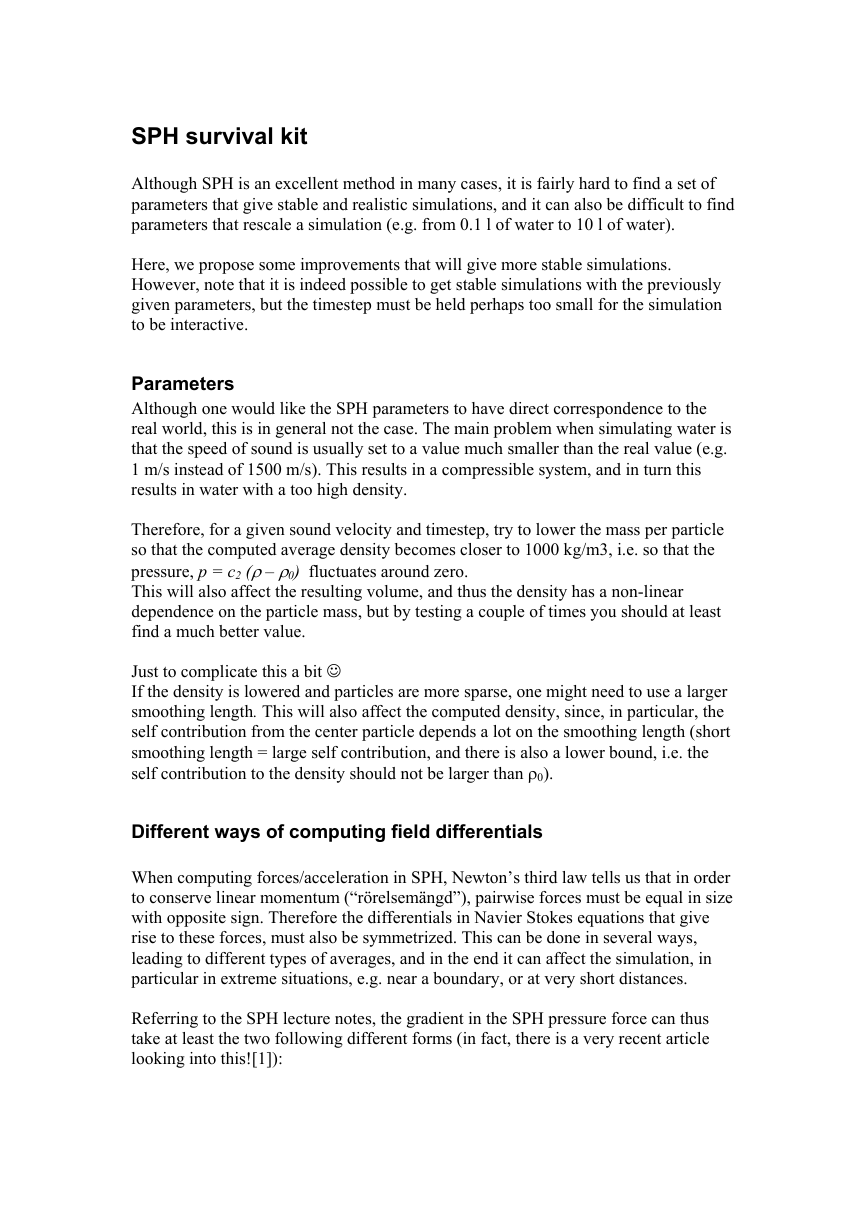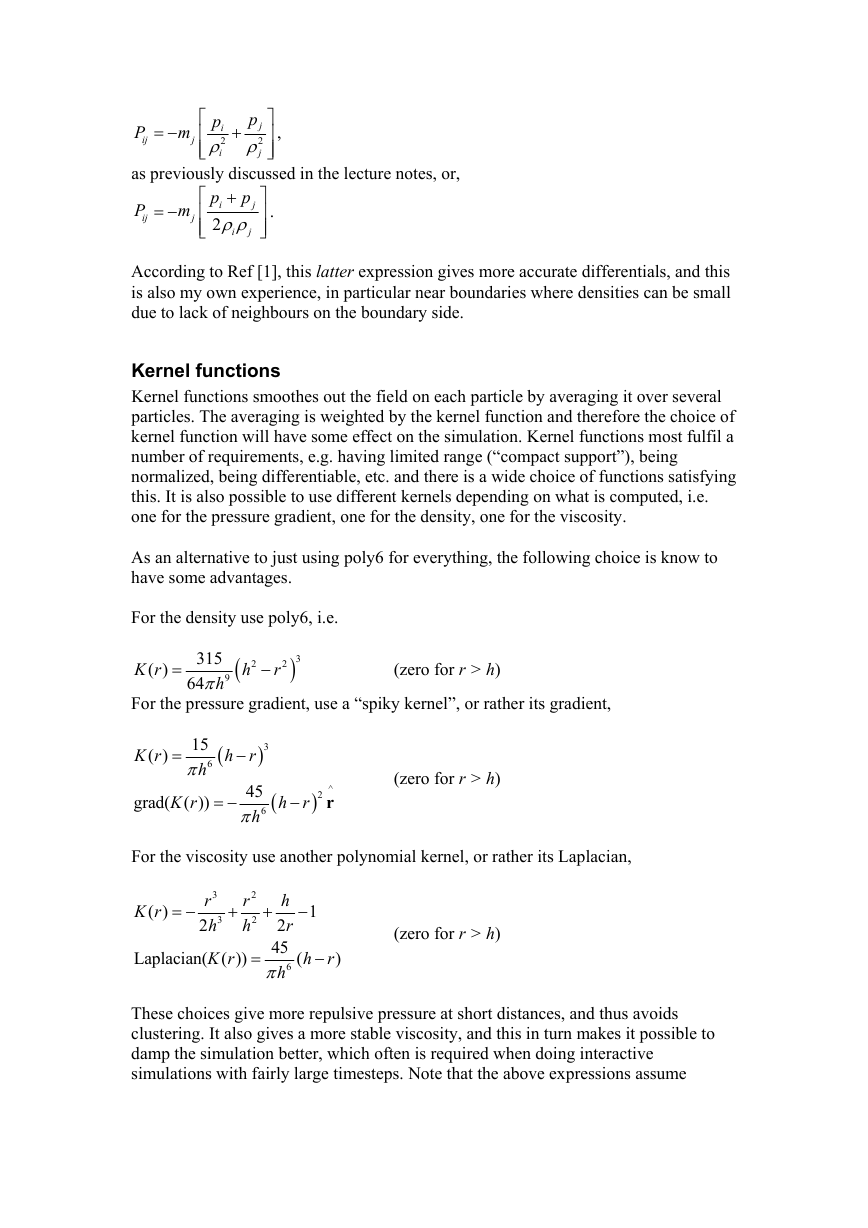SPH survival kit
Although SPH is an excellent method in many cases, it is fairly hard to find a set of
parameters that give stable and realistic simulations, and it can also be difficult to find
parameters that rescale a simulation (e.g. from 0.1 l of water to 10 l of water).
Here, we propose some improvements that will give more stable simulations.
However, note that it is indeed possible to get stable simulations with the previously
given parameters, but the timestep must be held perhaps too small for the simulation
to be interactive.
Parameters
Although one would like the SPH parameters to have direct correspondence to the
real world, this is in general not the case. The main problem when simulating water is
that the speed of sound is usually set to a value much smaller than the real value (e.g.
1 m/s instead of 1500 m/s). This results in a compressible system, and in turn this
results in water with a too high density.
Therefore, for a given sound velocity and timestep, try to lower the mass per particle
so that the computed average density becomes closer to 1000 kg/m3, i.e. so that the
pressure, p = c2 (ρ – ρ0) fluctuates around zero.
This will also affect the resulting volume, and thus the density has a non-linear
dependence on the particle mass, but by testing a couple of times you should at least
find a much better value.
Just to complicate this a bit ☺
If the density is lowered and particles are more sparse, one might need to use a larger
smoothing length. This will also affect the computed density, since, in particular, the
self contribution from the center particle depends a lot on the smoothing length (short
smoothing length = large self contribution, and there is also a lower bound, i.e. the
self contribution to the density should not be larger than ρ0).
Different ways of computing field differentials
When computing forces/acceleration in SPH, Newton’s third law tells us that in order
to conserve linear momentum (“rörelsemängd”), pairwise forces must be equal in size
with opposite sign. Therefore the differentials in Navier Stokes equations that give
rise to these forces, must also be symmetrized. This can be done in several ways,
leading to different types of averages, and in the end it can affect the simulation, in
particular in extreme situations, e.g. near a boundary, or at very short distances.
Referring to the SPH lecture notes, the gradient in the SPH pressure force can thus
take at least the two following different forms (in fact, there is a very recent article
looking into this![1]):
�
as previously discussed in the lecture notes, or,
P
ij
= −
m
j
P
ij
= −
m
j
⎡
⎢
⎢
⎣
⎡
⎢
⎢
⎣
p
p
j
i
2
2
ρ ρ
i
j
+
⎤
⎥
⎥
⎦
,
j
p
p
+
i
2
ρρ
j
i
⎤
⎥
⎥
⎦
.
According to Ref [1], this latter expression gives more accurate differentials, and this
is also my own experience, in particular near boundaries where densities can be small
due to lack of neighbours on the boundary side.
Kernel functions
Kernel functions smoothes out the field on each particle by averaging it over several
particles. The averaging is weighted by the kernel function and therefore the choice of
kernel function will have some effect on the simulation. Kernel functions most fulfil a
number of requirements, e.g. having limited range (“compact support”), being
normalized, being differentiable, etc. and there is a wide choice of functions satisfying
this. It is also possible to use different kernels depending on what is computed, i.e.
one for the pressure gradient, one for the density, one for the viscosity.
As an alternative to just using poly6 for everything, the following choice is know to
have some advantages.
For the density use poly6, i.e.
K r
( )
For the pressure gradient, use a “spiky kernel”, or rather its gradient,
K r
( )
(zero for r > h)
315
hπ
64
h r
−
)3
=
−
h
(
r
2
2
9
3
(
=
15
h
6
π
K r
( ))
)
45
h
6
π
(
^2
r
)
(zero for r > h)
3
2
+
+
= −
= −
h r
−
grad(
For the viscosity use another polynomial kernel, or rather its Laplacian,
K r
( )
r
3
h
2
K r
Laplacian(
These choices give more repulsive pressure at short distances, and thus avoids
clustering. It also gives a more stable viscosity, and this in turn makes it possible to
damp the simulation better, which often is required when doing interactive
simulations with fairly large timesteps. Note that the above expressions assume
h
r
2
45
hπ
6
(zero for r > h)
r
h
( ))
h r
−
−
=
1
(
)
2
�
that rij = ri – rj . With rij = rj – riinstead, there will be a sign change in the gradient
expression due to the inner derivative.
/Kenneth
References
1. F. Colin, R. Egli and F.Y. Lin, Computing a null divergence
velocity field using smoothed particle hydrodynamics, Journal of
Computational Physics, In Press, Corrected Proof, , Available online
24 February 2006.
http://www.sciencedirect.com/science/article/B6WHY-4JBGKMW-
5/2/0643112f85fe9f313e86911b63a6d890)
�






 2023年江西萍乡中考道德与法治真题及答案.doc
2023年江西萍乡中考道德与法治真题及答案.doc 2012年重庆南川中考生物真题及答案.doc
2012年重庆南川中考生物真题及答案.doc 2013年江西师范大学地理学综合及文艺理论基础考研真题.doc
2013年江西师范大学地理学综合及文艺理论基础考研真题.doc 2020年四川甘孜小升初语文真题及答案I卷.doc
2020年四川甘孜小升初语文真题及答案I卷.doc 2020年注册岩土工程师专业基础考试真题及答案.doc
2020年注册岩土工程师专业基础考试真题及答案.doc 2023-2024学年福建省厦门市九年级上学期数学月考试题及答案.doc
2023-2024学年福建省厦门市九年级上学期数学月考试题及答案.doc 2021-2022学年辽宁省沈阳市大东区九年级上学期语文期末试题及答案.doc
2021-2022学年辽宁省沈阳市大东区九年级上学期语文期末试题及答案.doc 2022-2023学年北京东城区初三第一学期物理期末试卷及答案.doc
2022-2023学年北京东城区初三第一学期物理期末试卷及答案.doc 2018上半年江西教师资格初中地理学科知识与教学能力真题及答案.doc
2018上半年江西教师资格初中地理学科知识与教学能力真题及答案.doc 2012年河北国家公务员申论考试真题及答案-省级.doc
2012年河北国家公务员申论考试真题及答案-省级.doc 2020-2021学年江苏省扬州市江都区邵樊片九年级上学期数学第一次质量检测试题及答案.doc
2020-2021学年江苏省扬州市江都区邵樊片九年级上学期数学第一次质量检测试题及答案.doc 2022下半年黑龙江教师资格证中学综合素质真题及答案.doc
2022下半年黑龙江教师资格证中学综合素质真题及答案.doc